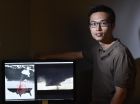Nano in food and agriculture: Regulations require collaboration to ensure safety
2015-09-11
(Press-News.org) An overview of regulatory solutions worldwide on the use of nanotechnology in food and feed production shows a differing approach: only the EU and Switzerland have nano-specific provisions incorporated in existing legislation, whereas other countries count on non-legally binding guidance and standards for industry. Collaboration among countries across the globe is required to share information and ensure protection for people and the environment, according to a JRC co-authored paper.
The paper Regulatory aspects of nanotechnology in the agri/feed/food sector in EU and non-EU countries reviews how potential risks or the safety of nanotechnology are managed in different countries around the world and recognises that this may have implication on the international market of nano-enabled agricultural and food products.
Nanotechnology offers substantial prospects for the development of innovative products and applications in many industrial sectors, including agricultural production, animal feed and treatment, food processing and food contact materials. While some applications are already marketed, many other nano-enabled products are currently under research and development, and may enter the market in the near future. Expected benefits of such products include increased efficacy of agrochemicals through nano-encapsulation, enhanced bioavailability of nutrients or more secure packaging material through microbial nanoparticles.
As with any other regulated product, applicants applying for market approval have to demonstrate the safe use of such new products without posing undue safety risks to the consumer and the environment. Some countries have been more active than others in examining the appropriateness of their regulatory frameworks for dealing with the safety of nanotechnologies. As a consequence, different approaches have been adopted in regulating nano-based products in the agri/feed/food sector.
The analysis shows that the EU along with Switzerland are the only ones which have introduced binding nanomaterial definitions and/or specific provisions for some nanotechnology applications. An example would be the EU labelling requirements for food ingredients in the form of 'engineered nanomaterials'. Other regions in the world regulate nanomaterials more implicitly mainly by building on non-legally binding guidance and standards for industry.
The overview of existing legislation and guidances published as an open access article in the Journal Regulatory Toxicology and Pharmacology is based on information gathered by the JRC, RIKILT-Wageningen and the European Food Safety Agency (EFSA) through literature research and a dedicated survey.
INFORMATION:
Related links:
Regulatory aspects of nanotechnology in the agri/feed/food sector in EU and non-EU countries:
http://www.sciencedirect.com/science/article/pii/S0273230015300088
ELSE PRESS RELEASES FROM THIS DATE:
2015-09-11
The list of potential mechanisms that underlie an unusual metal-insulator transition has been narrowed by a team of scientists using a combination of X-ray techniques. This transition has ramifications for material design for electronics and sensors.
The transition between being electrically conductive (metallic) at high temperatures and electrically insulating at lower temperatures is known as a metal-insulator transition (MIT). Pinpointing the activation mechanism that allows crystals used in devices such as transistors in electronics and temperature-based sensor control ...
2015-09-11
The light that typically floods homes, offices and public buildings could provide something more than illumination. Scientists at Disney Research and ETH Zurich have demonstrated that light could be a medium for light bulbs to communicate - with each other, with objects and with the Internet.
Transmitting signals via light is nothing new; Alexander Graham Bell showed that speech could be conveyed with light in the 1880s, years before speech was first transmitted via radio. The Disney researchers, however, have created networking technology that makes it possible for LED ...
2015-09-11
KANSAS CITY, MO -- Cellular mitosis depends in part on small organelles that extend spindles to pull apart chromosome pairs. Before they can perform this and other essential tasks, these tiny cylindrical structures -- known as centrioles in animals and spindle pole bodies (SPBs) in yeast -- must themselves duplicate.
However, much about this nanoscale process has remained veiled by the limits of current microscopy. Optical approaches cannot resolve objects below certain wavelength limits, while non-optical approaches like electron microscopy (EM) can only study nonliving ...
2015-09-11
What if tornado activity could be forecasted months, even seasons in advance? Thanks to a new model developed at the University of Toronto Scarborough, that ability could soon become a reality.
"The aim is to predict ahead to the following year or subsequent years about whether we'll get above or below average tornado activity in a given area," says Vincent Cheng, a postdoctoral fellow in UTSC's Ecological Modelling Lab.
The model, developed by Cheng, Professor George Arhonditsis and Professor Bill Gough in UTSC's Climate Lab along with colleagues at Environment Canada, ...
2015-09-11
Genetic mutations called "escape variants" in the deadly Ebola virus appear to block the ability of antibody-based treatments to ward off infection, according to a team of U.S. Army scientists and collaborators. Their findings, published online this week in the journal Cell Reports, have implications for the continued development of therapeutics to treat Ebola virus disease, which has claimed the lives of over 11,000 people in West Africa since last year.
Ebola virus overruns the immune system, thus overwhelming the host's ability to fight off the infection. One strategy ...
2015-09-11
PhD candidate Matt Shultz has discovered the first massive binary star, epsilon Lupi, in which both stars have magnetic fields. A binary star is a star system consisting of two or more stars, orbiting around their common centre of mass.
For the past few years, the BinaMIcS (Binarity and Magnetic Interactions in various classes of Stars) collaboration, formed to study the magnetic properties of close binaries, has been trying to find such an object. They have now discovered one using the Canada-France-Hawaii Telescope.
"The origin of magnetism amongst massive stars is ...
2015-09-11
LEXINGTON, Ky. (Sept. 8, 2015) -- A new University of Kentucky study in the journal mBio shows that tissue cysts of the parasite Toxoplasma gondii, long thought to be dormant, are quite active.
Led by Anthony Sinai, professor at the UK College of Medicine, the study has significant implications on the understanding of chronic toxoplasmosis in the brain, a condition suggested to contribute to a range of neurological diseases including schizophrenia in humans, and the modulation of behavior in rodents.
Toxoplasmosis can be acquired from the droppings of infected cats ...
2015-09-11
Using metallic osmium (Os) in experimentation, an international group of researchers have demonstrated that ultra-high pressures cause core electrons to interplay, which results in experimentally observed anomalies in the compression behavior of the material.
Os is one of Earth's most exceptional elemental materials, possessing the highest known density at ambient pressure, one of the highest cohesive energies and melting temperatures, and an incompressibility that is almost comparable to that of diamond.
Researchers believe that the ability to affect core electrons ...
2015-09-11
Open source lab equipment is the focus of a new study, published in Science and Public Policy. Joshua Pearce, an associate professor of materials science and engineering as well as electrical and computer engineering at Michigan Tech, led the research. Pearce proposes that instead of spending millions of dollars every year replacing quickly obsolescent equipment, that money could be redirected to developing open source tools that are "upgradeable and transformable--they will be continuously updated" using digital manufacturing techniques such as 3-D printing.
The benefits ...
2015-09-11
The politics of climate change are often depicted as a simple battle, between environmentalists and particular industries, over government policy. That's not wrong, but it's only a rough sketch of the matter. Now a paper co-authored by MIT economist Christopher Knittel fills in some important details of the picture, revealing an essential mechanism that underlies the politics of the climate battle.
Specifically, as Knittel and his colleagues demonstrate, at least one climate policy enacted by Congress -- on transportation fuels -- contains a crucial asymmetry: It imposes ...
LAST 30 PRESS RELEASES:
[Press-News.org] Nano in food and agriculture: Regulations require collaboration to ensure safety


